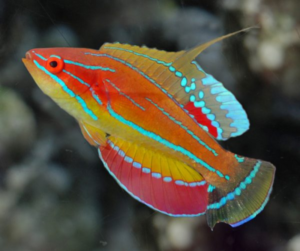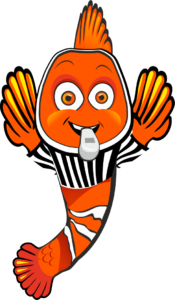- Basic Facts About Wrasse
- How will a Wrasse behave in your aquarium?
- How to acclimate your Wrasse to your fish tank?
- Which Species Are Best To Pair With Your Wrasse?
- Most Popular Types of Wrasse
- Medicine or Treatments for Common Wrasse Illnesses
- Ohfishal Wrasse Fish Tank Set Up
- Frequently Asked Questions about Wrasse
Basic Facts About Wrasse

| Scientific Family: | Labridae |
| Number of Clownfish Species Types: | There are over 600 species types of Wrasse. |
| Average Life Span: | Most Wrasse live between 3 and 8 years. |
| Typical Size: | Typically Wrasse are between 2 and 8 inches. Most average around 3-4 inches. The humphead wrasse can measure up to 8 ft long, but we don’t think you’re going to put that in your personal aquarium. |
| Colors: | The rainbow! Between all of the species, you can find almost any color in Wrasses. Green tends to be a common base color. |
| Native To: | Atlantic, Pacific and Indian Oceans. These are saltwater fish. Almost all are found in sub-tropical waters. |
| Water Conditions Needed: | Temperature (Farenheit): 72-85°F PH Level: 8.1-8.4 Gravity: 1.020 and 1.025 |
| What Do Wrasse Eat?: | Wrasse are carnivores. They really like invertabrates. You can also feed them a variety of meaty things such as tiny crustaceans copepods, fish eggs and larvae, certain shrimp, and finely chopped fish. You can also feed them flakes and pellets if you want them to get some veggies. Feed adults 2 times a day. |
| Fish-Keeping Experience Level: | Most Wrasse are good for beginner fish keepers, which is why they are so popular. |
| Minimum Tank Size: | For the most common wrasse, like the 6-line wrasse, you need a bigger tank, we recommend minimum size of 50 Gallons for 1 Wrasse. You should be able to add multiple fish in that 50 gallon aquarium. Some types of Wrasse can be kept in smaller aquariums, but as always we recommend you err on the larger side, both for ease of fish keeping and for your fishes happiness! |
| Tank Accessory Requirements: | Heater and Filter. Protein Skimmers are recommended. |
| Compatibility – Other Fish: | Check the species of wrasse, but most wrasse make great tank mates for most species of saltwater fish. Angels, Box Fish, Clownfish, Damsels, and Tangs are our the most recommended fish to make friends of your wrasses. |
| Compatibility – Plants: | Live Soft or Hard Corals |
| Compatibility – Do not Keep With These Species: | We would avoid keeping your Wrasse with Seahorse, Pipefish, Sharks, Rays. |
| Can you breed them? | It is very difficult. You’ll need a really large tank, 125+ gallons. |
| Fun Fact: | Wrasses have unique jaws that are studied by a lot of scientists. These fish usually have separate “jaw teeth” that jut out from their mouth, and Wrasse move their jaws out uniquely. |
| Cost: | $20-$200 Wrasse can be a little pricey. Depending on the type, a lot of the unique species can cost more than $100. Most of the common types are between $30 and $50. |

How will a Wrasse behave in your aquarium?
Wrasse tend to be pretty active. Some will burrow, most will jump if you leave your tank uncovered, but all will swim around actively. This is why we recommend that you give them plenty of room, especially if you are going to keep them with other fish as well.
How to acclimate your Wrasse to your fish tank?
When you get your Wrasse, there are a few ways you can introduce your new prized possession to your aquarium. We’ll walk you through one of the easier ways, the Floating Method, but know that there are other ways you can do this as well. Another method for introducing your Wrasse to your fish tank is the Drip Method,
Floating Method:
Step 1: Turn off all lights on your aquarium and dim the lights in the room. Remember, your Wrasse has likely been shipped in a dark box, so we don’t want to cause them to freak out by flooding them with lights.
Step 2: Place the bag with the Wrasse in it in your aquarium and let it float. Don’t open the bag yet. Let the bag float for about 15 minutes. Doing this will let the temperature of the water in the bag to match the temperature of the water in your aquarium.
Step 3: Once you’ve had the bag in the water for 15 minutes, cut a small hole in the bag (if there’s a metal clip, cut the hole right below the metal clip). Open the hole wide enough, and then pour in 1/2 a cup of your aquarium water to the bag. Continue to add 1/2 cup of aquarium water every four minutes until the bag is full.
Step 4: Once the bag is full, take the bag and pour out half of the water (not into your aquarium). Repeat step 3 again. This time, when the bag is full, you’ll net your Wrasse and put it into your fish tank! Make sure to remove the shipping bag from your aquarium, and again, don’t pour the water from the bag into the aquarium but discard of it elsewhere (like your sink).
Which Species Are Best To Pair With Your Wrasse?
- Anglefish
- Damselfish
- Clownfish
- Tangs
- Box Fish
Most Popular Types of Wrasse
- Six Line Wrasse
- Melanurus Wrasse
- Bluestreak Cleaner Wrasse
- Fairy Wrasses
- Christmas Wrasse
- Napoleon Wrasse
- Yellow or Red Coris Wrasse
- Bluehead Wrasse
Medicine or Treatments for Common Wrasse Illnesses
- Water Changes
- Quarantine Tanks
- Get a Cleaner Shrimp
- Increase Water Temperature
- Decrease Water Temperature
- Aquarisol
- Zeolite
Ohfishal Wrasse Fish Tank Set Up
This is our ultimate checklist for a fish tank with a Wrasse. Of course, you can do this with less parts, or different parts, but this is our all-in ohfishal recommendation. This set-up will run you around $430 (market prices will vary).
- Fish Tank, Light, Heater and Filter – 55 Gallon Top Fin Essentials Aquarium Starter Kit – $150
- Species – 2 Wrasses ($60), 1 Clownfish ($30),1 Gobie ($20), 1 Bubble Coral – ($50) – an easy place to shop is Live Aquaria.
- Protein Skimmer – $100
- Sponge Filter and Air Pump – $20
Frequently Asked Questions about Wrasse
Yes, you can, but you should make sure they are the same species of Clownfish. Otherwise, they will get aggressive to each other. If you can introduce all the Clownfish to your tank at the same time too, that is ideal.
Yes, but you’ll have to do a few things differently. First, you’ll need to feed them more, likely 3+ times per day. Second, you’ll likely need to raise the water temperature above 80 degrees.
That really depends on your Clownfish, but most will live to be around 6 years old.
